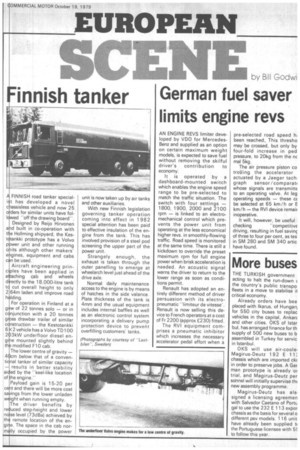Finnish tanker
Page 45

If you've noticed an error in this article please click here to report it so we can fix it.
FINNISH road tanker specialit has developed a novel c assisless vehicle and now 26 ders for similar units have folwed ''off the drawing board''. Designed by Reijo Hirvonen a d built in co-operation with e Hollming shipyard, the Kestankki prototype has a Volvo wer unit and other running its although other makers' gines, equipment and cabs n be used.
Aircraft engineering prin c pies have been applied in a aching cab and wheels d ectly to the 1 8 ,000-litre tank t cut overall height to only 2 64m laden and improve road hiding.
For operation in Finland at a of 22 tonnes solo — or in c njunction with a 20 tonnes ss drawbar trailer of similar c nstruction — the Kestotankki 6 2 vehicle has a Volvo TD100 203kW underfloor diesel engine mounted slightly behind -the modified F10 cab.
The lower centre of gravity — 4 cm below that of a conven
tichal tanker of similar capacity results in better stability aided by the "keel-like location of the engine."
Payload gain is 1 5-20 per c4it and there will be more cost savings from the lower unladen weight when running empty.
The driver benefits by reduced step-height and lower noise level (73dBa) achieved by the remote location of the engir e. The space in the cab normally occupied by the power unit is now taken up by air tanks and other auxiliaries.
With new Finnish legislation governing tanker operation coming into effect in 1 982 special attention has been paid to effective insulation of the engine from the tank. This has involved provision of a steel pod screening the upper part of the power unit.
Strangely enough, the exhaust is taken through the outer panelling to emerge at .wheelarch level just ahead of the drive axle.
Normal daily maintenance access to the engine is by means of hatches in the side valance. Plate thickness of the tank is 4mrn and the usual equipment includes internal baffles as well as an electronic control system incorporating a delivery pump protection device to prevent overfilling customers tanks.












































































































































